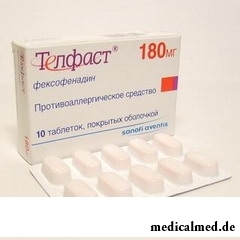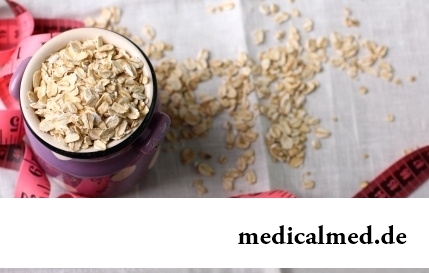





Телфаст
Application instruction:
Телфаст – means for treatment of allergic diseases.
Pharmacological action
Телфаст became the first antihistamine of the third generation and it is deprived of many side effects of the previous two generations.  The main component of drug – фексофенадин which is an active metabolite of a terfenadin thanks to этомуон has twice big affinity to histamine H1 receptors. Телфаст vysokoizbiratelno contacts H1 receptors and, blocking them, it does not allow to be shown to biological effects of a histamine in the form of symptoms of allergic diseases (allergic dermatitis, cold, sneezing, dacryagogue, a skin itch, etc.). Drug is capable to stabilize somewhat membranes of mast cells, preventing and reducing release from them biologically active agents, first of all a histamine.
The main component of drug – фексофенадин which is an active metabolite of a terfenadin thanks to этомуон has twice big affinity to histamine H1 receptors. Телфаст vysokoizbiratelno contacts H1 receptors and, blocking them, it does not allow to be shown to biological effects of a histamine in the form of symptoms of allergic diseases (allergic dermatitis, cold, sneezing, dacryagogue, a skin itch, etc.). Drug is capable to stabilize somewhat membranes of mast cells, preventing and reducing release from them biologically active agents, first of all a histamine.
Unlike the analogs Telfast does not get through a blood-brain barrier into a brain therefore has no sedative properties. It does not influence the speed of mental reactions and ability to concentrate attention, for example, at management of transport or during study. Телфаст on the instruktsiyena causes accustomings even at long use.
The research of effect of drug was conducted as invitro, and in clinical conditions, and everywhere he confirmed the high performance. It was proved what in comparison with the analogs of Telfast does not influence other receptors, including kinds of histamine N1-and H2 receptors. It has no anticholinergic and anti-adrenergic activity therefore side effects from stimulation of other types of receptors are absent.
Телфаст does not change slow potassium currents therefore does not influence a heart electrophysiology in any way – QT interval on the electrocardiogram does not change during administration of drug. Lack of cardiotoxicity does it by an alternative to a terfenadin.
Drug is quickly soaked up, its medical effect appears in 1 hour after intake, reaching the maximum force in 6 hours. The general duration of action of Telfast according to the instruction makes slightly more than 24 hours, thanks to it it can be accepted once a day. Force of action has it linear dependence on the accepted dose. Medicine is practically not exposed to metabolism in an organism and is removed in an invariable view with a stake (80%) and urine (10%).
Release form
Drug is produced in tablets on 30 mg (a children's form), by 120 mg and 180 mg.
Indications to Telfast's use
Телфаст according to the instruction it is recommended for treatment of such allergic diseases as seasonal allergic rhinitis and hay fever, a chronic idiopathic and allergic small tortoiseshell, Quincke's diseases (Quincke's edemas).
Contraindications
It is impossible to accept drug at its individual intolerance, during pregnancy and feeding by a breast. Reviews of Telfasta at children up to 6 years are absent therefore administration of drug for them is not recommended. With caution it is necessary to take it at pathology of a liver and kidneys.
Application instruction of Telfast
Drug is accepted inside once a day, washing down with enough water. Though food also does not influence receipt of medicine in blood, it is desirable to accept it to food. The concomitant use with antacids slows down Telfast's absorption therefore between them there has to be an interval not less than 2 hours. Researches showed that elderly patients do not need recalculation of a dose towards its reduction or lengthening of an interval between receptions.
For treatment of seasonal allergic rhinitis, since 12-year age, recommend to accept 120 mg of drug once a day, in case of a chronic idiopathic small tortoiseshell and Quincke's diseases of 180 mg once a day. To children from 6 to 12 years Telfast appoint 30 mg once a day. Duration of a course is individual, is defined by the attending physician. Long reception of Telfast up to 4 – 6 weeks is possible.
Side effect of Telfast
According to Telfast it is well transferred by patients, occasionally there are headaches, dizziness, nausea. Extremely seldom register cases of an asthma, a dermahemia and anaphylactic reactions.
The most high temperature of a body was recorded at Uilli Jones (USA) who came to hospital with a temperature of 46,5 °C.

The popular expression "run from a heart attack" became the motto of the people supporting active lifestyle. Moreover, run became peculiar...
Section: Articles about health
Olive oil – the product capable to make a powerful contribution to health of the person if it includes it in the diet. The rich vitamin composition of oil does it by a product number one from many diseases including from deadly. Only two tablespoons...
Section: Articles about health
The cosmetics intended for improvement of a condition of skin, nails and hair are used by each woman. Expenses on regular acquisition of the fashionable widely advertized products of well-known companies for many become very notable and significantly burden the family budget. Meanwhile, there is a number of inexpensive pharmaceutical drugs which can quite be applied in the cosmetic purposes. At the same time the effect of their use is often more noticeable, than result of use of the most expensive...
Section: Articles about health
Eyes – unique body on the structure thanks to which the person obtains about 80% of information on the world around: about a form...
Section: Articles about health
According to doctors, more than a half of men of 25-50 years suffer from frustration of the urinogenital sphere, but the minority sees a doctor from them. And in vain - even the insignificant discomfort in the field of generative organs can serve as a symptom of an illness fraught heavy посл...
Section: Articles about health
The name of this disease precisely reflects the problem reason: it consists in the bra fastener pressure upon a certain zone of a back. At the same time one of vertebrae of chest department of a backbone is as if blocked and loses mobility, and the loading falling on it is distributed on the next vertebrae. At 70-80% of women local pains in a backbone point on which the fastener of the often put most on bra presses result....
Section: Articles about health
Visit of doctors – business not the most pleasant, and many people do not hurry to undergo necessary planned inspections. Such behavior...
Section: Articles about health
The summer of this year in Russia was very ambiguous. Regions suffered from a merciless heat, from pouring rains, the hail from time to time dropped out, then there was again a heat which alternated with rainfall again. Many people suffer from such sharp changes of weather...
Section: Articles about health
Life activity of one-celled fungi of the sort Candida, related to yeast is a proximate cause of development of candidiasis (milkwoman). Normal these microorganisms are a part of the microflora living in an oral cavity and intestines of most of people and also in a female genital tract. The pathological phenomena are observed when fungi begin to breed too violently. At the same time there is an inflammatory process affecting mucous membranes and which is shown very nepr...
Section: Articles about health
Statistically, pathologies of a thyroid gland in the world more than 500 million people have. Failures in work of this body conduct to is heavy...
Section: Articles about health
Venereal diseases in medicine are called the infections which are transmitted preferential sexually, now they and are called - infections, sexually transmitted, or STD. Among them is also life-threatening. In spite of the fact that majority...
Section: Articles about health
Within several decades of our compatriots convinced that the use of butter nasty affects a condition of coronary vessels. As a result the reputation of a product was impaired thoroughly a little, and many almost ceased to include it in the diet, having given preference "to safer" to vegetable fats. Meanwhile, the last researches showed that harm of butter for health is strongly exaggerated. But the product has a number of unique properties, to...
Section: Articles about health
We live during an advertizing era. Daily each person receives a solid portion of persuasive councils about what to eat to be здо...
Section: Articles about health
The list of stereotypes of which, apparently, all know strongly includes following: British surely eat porridge for breakfast. Perhaps, not all modern residents of Britain arrive quite so, but for those from them which continue to follow this t...
Section: Articles about health
The phenomenon of improvement of a condition of the patients at administration of drugs who are not containing active agents, so-called effect of placebo is known long ago. At the end of the 18th century the American doctor Perkins began to treat people the "miracle" sticks made of alloy of steel and brass. Was for several minutes to press such subject enough to a sore point that it became much easier for the patient. Having suspected Perkins of charlatanism, his colleagues tried to repeat "miracle" by means of sticks, steles...
Section: Articles about health
Producers of milk mixes for children assure: mixes are ideally balanced and adapted for needs of babies. In a sluch...
Section: Articles about health
All diseases from nerves – in this joke a big element of truth, are said by doctors. Constant stresses lead to decrease in protective forces of an organism, and it becomes vulnerable for a set of diseases. It is wrong to think that the stress is a problem of the present. Life of people and hundred...
Section: Articles about health
Smack in a mouth can arise in the natural way – as a result of lack of morning hygiene or reception of the corresponding food. However in certain cases its existence is a sign of certain pathologies, and allows to reveal an illness at an early stage. Depending on character of aftertaste – acid, salty, bitter, sweet – distinguish also diseases which accompany it....
Section: Articles about health
Work of a brain is extremely complex and in many respects is not studied yet. It is confirmed also by the features of thought processes which are shown in...
Section: Articles about health
Radiological methods of a research are applied in medicine more than hundred years, and thanks to them millions of lives were saved. In many cases without X-ray it is impossible to make exact idea of a condition of bodies and fabrics, it is correct to make the diagnosis. Those...
Section: Articles about health
The state of health of the person depends on many factors. One of the most important is the constant, but not exhausting a physical activity. In the presence of various illnesses specialists often advise patients to do swimming which by right takes the leading place by efficiency of improvement, having at the same time a few contraindications. Today we will talk about the main directions of therapeutic impact of swimming on a human body....
Section: Articles about health
Very often as a source of the infection which caused a disease serves our house - the place which a priori has to be safe. However...
Section: Articles about health
Separate food - the system of meal based on digestion physiology which is carried to improvement methods. According to nutritionists, the separate use of the carbohydrate and proteinaceous products demanding different conditions of assimilation helps to get rid from Bol...
Section: Articles about health
The concept "gluten" (differently, a gluten) combines group of the proteins which are a part of rye, barley and wheat. For most of people the use of the food stuffs containing a gluten not only is safe, but also it is very useful. Nevertheless, there is a number of myths about negative effect which allegedly gluten has on health of the person....
Section: Articles about health
Dogrose – one of the most widespread adornment and medicinal plants growing practically in all territory ours...
Section: Articles about health
Dark circles (bruises) under eyes – a shortcoming with most of which often fight against the help of cosmetics (proofreaders, saloon procedures and so forth), eliminating only its visibility. However, according to doctors, skin around eyes – the indicator of many disturbances in an organism...
Section: Articles about health
(Xerostomia) many people consider feeling of a xerostomia small and easily removable inconvenience. This delusion: the symptom can demonstrate existence of serious diseases. It is worth to remember also that saliva performs important functions in an organism: clears the surface of teeth of a food plaque, growth of pathogenic microorganisms oppresses, normalizes acid-base balance, liquefies food and helps to split the carbohydrates which are contained in it. Chronic deficit слюн...
Section: Articles about health
